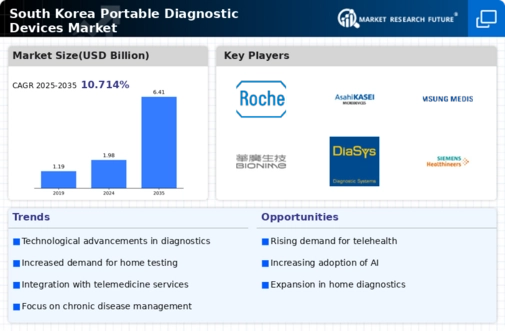Aging Population
South Korea's demographic shift towards an aging population significantly influences the portable diagnostic-devices market. By 2025, it is estimated that over 20% of the population will be aged 65 and older, creating a heightened demand for healthcare services. This demographic trend necessitates the use of portable diagnostic devices that can provide timely and accurate health assessments, particularly for chronic conditions prevalent among older adults. The convenience and accessibility of these devices enable healthcare providers to monitor patients remotely, reducing the need for frequent hospital visits. Consequently, The portable diagnostic-devices market is likely to expand as healthcare systems adapt to the needs of an aging society. This focus on solutions enhances patient management and improves quality of life.
Rising Healthcare Expenditure
The increasing healthcare expenditure in South Korea is a pivotal driver for the portable diagnostic-devices market. As the government allocates more funds towards healthcare, the demand for innovative diagnostic solutions rises. In 2025, healthcare spending is projected to reach approximately 9.5% of GDP, indicating a robust investment in health technologies. This trend suggests that healthcare providers are more inclined to adopt portable diagnostic devices to enhance patient care and streamline operations. Furthermore, the emphasis on preventive healthcare is likely to bolster the market, as portable devices facilitate early diagnosis and monitoring, ultimately leading to better health outcomes. The portable diagnostic-devices market is thus positioned to benefit from this increased financial commitment to healthcare, as stakeholders seek efficient and effective diagnostic tools.
Shift Towards Home Healthcare
The shift towards home healthcare is emerging as a significant driver for the portable diagnostic-devices market. With an increasing number of patients preferring to receive care in the comfort of their homes, there is a growing demand for portable diagnostic solutions that enable effective monitoring and management of health conditions. In South Korea, the home healthcare market is projected to grow by 25% by 2025, reflecting a broader trend towards patient-centered care. Portable diagnostic devices facilitate this transition by providing healthcare professionals with the tools needed to conduct assessments remotely. This trend not only enhances patient satisfaction but also reduces the burden on healthcare facilities, indicating a promising outlook for the portable diagnostic-devices market.
Government Initiatives and Funding
Government initiatives aimed at promoting health technology innovation play a significant role in driving the portable diagnostic-devices market. In South Korea, various funding programs and grants are available to support research and development in medical technologies. The government has committed to investing over $1 billion in health tech initiatives by 2026, which is expected to stimulate advancements in portable diagnostic devices. These initiatives not only encourage local startups and established companies to innovate but also enhance collaboration between public and private sectors. As a result, the portable diagnostic-devices market is likely to benefit from increased funding and support, fostering an environment conducive to technological advancements and market growth.
Technological Integration in Healthcare
The integration of advanced technologies into healthcare practices is a crucial driver for the portable diagnostic-devices market. Innovations such as artificial intelligence (AI), machine learning, and telemedicine are increasingly being incorporated into diagnostic devices, enhancing their functionality and accuracy. In South Korea, the adoption of AI in healthcare is projected to grow by 30% annually, indicating a strong trend towards smart diagnostic solutions. This technological evolution not only improves diagnostic capabilities but also facilitates real-time data sharing between patients and healthcare providers. As a result, the portable diagnostic-devices market is likely to experience growth as stakeholders seek to leverage these technologies to improve patient outcomes and operational efficiency.


















Leave a Comment